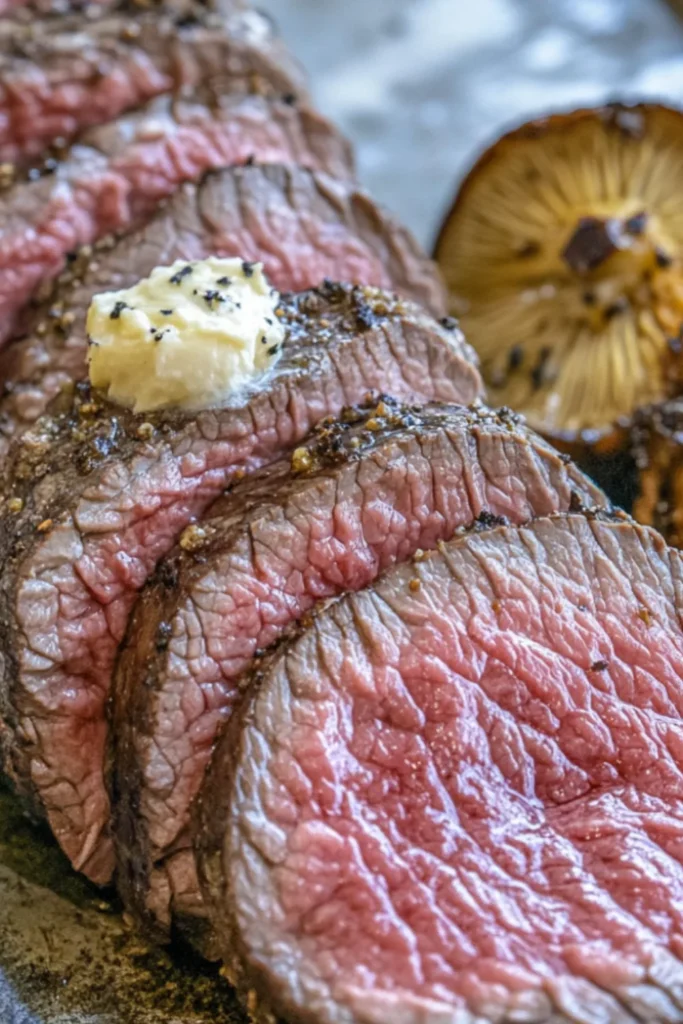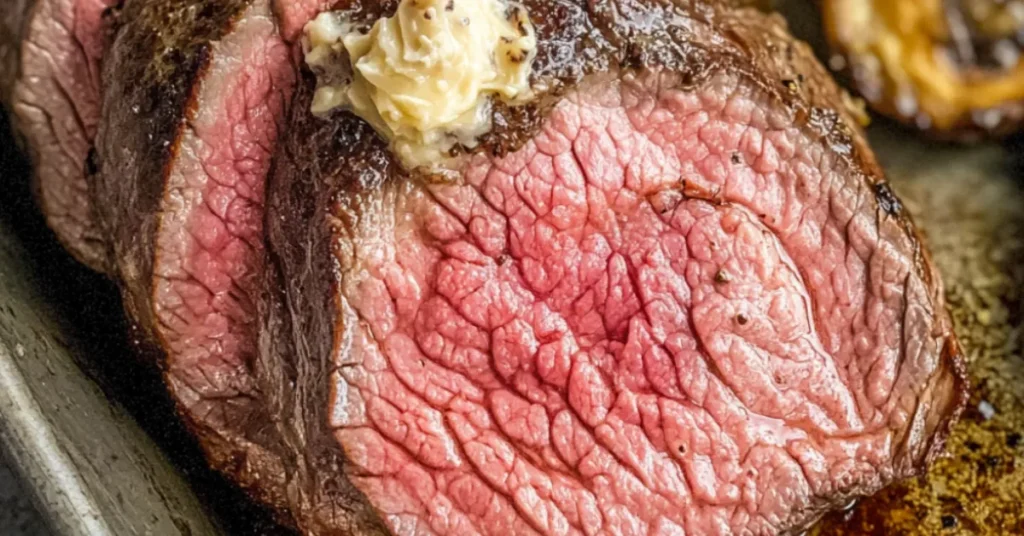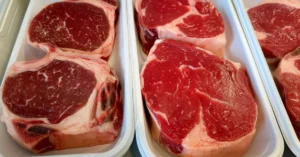Table of Contents
When it comes to premium beef cuts, the teres major steak is a hidden gem that’s slowly stealing the spotlight. Often referred to as the “shoulder tender” or “petite tender,” this cut is celebrated for its incredible tenderness and rich flavor, rivaling even the famed filet mignon. But what makes it so special? In this article, we’ll dive deep into everything you need to know about teres major steak—from its origins and nutritional benefits to cooking techniques, pairing ideas, and even tips on buying and storing it. Whether you’re a seasoned chef or a home cook looking to impress, this guide will equip you with all the knowledge to master this underrated cut. Let’s get started
What is Teres Major Steak?
What is Teres Major Steak?
If you’ve never heard of teres major steak, you’re not alone. This lesser-known cut comes from the shoulder of the cow, specifically the teres major muscle. Despite its humble location, it’s one of the most tender cuts you’ll find—thanks to its minimal use during the animal’s life. Often dubbed the “butcher’s secret,” it’s a favorite among chefs and meat enthusiasts who appreciate its melt-in-your-mouth texture and robust flavor.
Definition and Origin
The teres major muscle is a small, oblong muscle located near the shoulder blade. Unlike other shoulder cuts, which tend to be tougher due to constant movement, this muscle remains relatively inactive. As a result, it develops a fine grain and buttery texture that’s perfect for steaks. Its name, teres major, comes from Latin, meaning “rounded and larger,” which perfectly describes its shape.
Interestingly, this cut was once reserved for butchers and restaurant insiders. However, as more people discover its potential, it’s becoming a sought-after choice for home cooks and steak lovers alike.
Why Teres Major Steak is Gaining Popularity
So, why is teres major steak suddenly trending? For starters, it’s incredibly versatile. Whether you’re grilling, pan-searing, or using a sous vide machine, this cut delivers consistent results. Plus, it’s more affordable than other premium cuts like filet mignon, making it a budget-friendly option for special occasions.

Another reason for its rise in popularity is its nutritional profile. Packed with high-quality protein and essential nutrients, it’s a healthier alternative to fattier cuts. And let’s not forget the flavor—its rich, beefy taste pairs beautifully with a variety of seasonings and sauces.
Nutritional Profile of Teres Major Steak
When it comes to nutrition, teres major steak is a powerhouse. A 3-ounce serving typically contains around 22 grams of protein, making it an excellent choice for muscle repair and growth. It’s also relatively low in fat, with only about 6 grams per serving, and provides essential vitamins and minerals like iron, zinc, and B vitamins.
- Macronutrients (Protein, Fat, Carbs)
- Protein: 22g per 3-ounce serving.
- Fat: 6g (mostly unsaturated fats).
- Carbs: 0g (perfect for low-carb diets).
- Vitamins and Minerals
- Iron: Supports oxygen transport in the blood.
- Zinc: Boosts immune function and metabolism.
- B Vitamins: Essential for energy production.
- Health Benefits of Consuming Teres Major Steak
- Promotes muscle growth and repair.
- Supports heart health with lean protein.
- Provides sustained energy without excess calories.
In short, teres major steak isn’t just delicious—it’s also a nutritious addition to your diet.
more recipes: Knorr Vegetable Dip Recipe
How to Cook Teres Major Steak Perfectly
How to Cook Teres Major Steak Perfectly
Cooking teres major steak is a breeze once you know the right techniques. Unlike tougher cuts that require slow cooking, this tender muscle shines with quick, high-heat methods. Whether you’re a grilling enthusiast or a fan of pan-searing, we’ve got you covered. Let’s break it down step by step.
Preparing the Steak
Before you fire up the grill or heat the pan, proper preparation is key. Here’s how to get your teres major steak ready for cooking.
- Trimming and Cleaning
Start by inspecting the steak for any excess fat or silver skin. While a little fat adds flavor, too much can cause flare-ups on the grill. Use a sharp knife to trim away any unwanted bits. Then, pat the steak dry with paper towels. Moisture is the enemy of a good sear, so this step is crucial. - Marinating Tips for Maximum Flavor
While teres major steak is flavorful on its own, a good marinade can take it to the next level. For a classic approach, mix olive oil, minced garlic, rosemary, and a splash of balsamic vinegar. Let the steak marinate for at least 30 minutes, or up to 4 hours in the fridge. If you’re short on time, a simple rub of salt, pepper, and smoked paprika works wonders.
Cooking Methods
Now comes the fun part—cooking! Here are four foolproof methods to cook teres major steak to perfection.
- H3: Grilling Teres Major Steak
Grilling is a fantastic way to highlight the natural flavors of teres major steak. Preheat your grill to medium-high heat (around 400°F). Place the steak on the grill and cook for 4-5 minutes per side for medium-rare. Use a meat thermometer to ensure the internal temperature reaches 130-135°F. Let the steak rest for 5-10 minutes before slicing.Pro Tip: For those beautiful grill marks, avoid moving the steak around too much. Let it sear undisturbed for the first few minutes. - Pan-Searing Teres Major Steak
If you don’t have a grill, pan-searing is an excellent alternative. Heat a cast-iron skillet over medium-high heat and add a tablespoon of oil. Once the oil is shimmering, place the steak in the pan. Sear for 3-4 minutes on each side, then reduce the heat and add butter, garlic, and thyme for extra flavor. Baste the steak with the melted butter for a minute or two before removing it from the pan. - Sous Vide Cooking
For those who love precision, sous vide is the way to go. Set your sous vide machine to 130°F for medium-rare. Season the steak, seal it in a vacuum bag, and cook it in the water bath for 1-2 hours. Afterward, sear it in a hot skillet for 1-2 minutes per side to develop a crispy crust. - Oven Roasting
Oven roasting is ideal for larger cuts or when cooking multiple steaks. Preheat your oven to 400°F. Sear the steak in a hot skillet for 2-3 minutes per side, then transfer it to the oven. Roast for 10-15 minutes, or until the internal temperature reaches 130-135°F.
Resting and Slicing
No matter which cooking method you choose, resting the steak is non-negotiable. Transfer the cooked steak to a cutting board and let it rest for 5-10 minutes. This allows the juices to redistribute, ensuring every bite is juicy and flavorful.
When it’s time to slice, cut the steak against the grain. This breaks up the muscle fibers, making each piece even more tender.
Best Seasonings and Marinades for Teres Major Steak
While teres major steak is delicious with just salt and pepper, experimenting with seasonings can elevate your dish.
- Classic Salt and Pepper Rub
Sometimes, simplicity is best. A generous sprinkle of kosher salt and freshly ground black pepper is all you need to let the steak’s natural flavors shine. - Herb-Based Marinades
Combine olive oil, minced garlic, rosemary, thyme, and a squeeze of lemon juice for a fresh, herbaceous marinade. This pairs beautifully with the steak’s rich flavor. - Spicy and Exotic Flavors
For a bold twist, try a marinade with soy sauce, ginger, chili flakes, and a touch of honey. The sweet and spicy combo adds an exciting kick to the steak.
Pairing and Serving Teres Major Steak
What to Serve with Teres Major Steak
A perfectly cooked teres major steak deserves equally impressive sides and accompaniments. Whether you’re hosting a dinner party or enjoying a cozy meal at home, the right pairings can turn your steak into a feast. Let’s explore some mouthwatering options.
Side Dishes
The right side dish can complement the rich flavors of teres major steak without overpowering it. Here are some classic and unique ideas to try.
- Classic Steakhouse Sides
- Garlic Mashed Potatoes: Creamy, buttery, and infused with roasted garlic, this classic side is a crowd-pleaser.
- Grilled Asparagus: Lightly charred asparagus adds a fresh, slightly smoky contrast to the steak.
- Creamed Spinach: A rich and indulgent side that pairs beautifully with the steak’s tenderness.
- Unique Pairings
- Quinoa Salad: For a healthier option, toss cooked quinoa with cherry tomatoes, cucumbers, feta cheese, and a lemon vinaigrette.
- Roasted Vegetables: A medley of carrots, Brussels sprouts, and sweet potatoes roasted with olive oil and herbs adds color and flavor to your plate.
- Truffle Fries: Elevate your meal with crispy fries tossed in truffle oil and Parmesan cheese.
Sauces and Toppings
A great sauce can take your teres major steak from good to unforgettable. Here are three delicious options to try.
- Red Wine Reduction
Simmer red wine, beef broth, shallots, and thyme until the mixture thickens into a rich, glossy sauce. Drizzle it over the steak for a touch of elegance. - Chimichurri Sauce
This vibrant Argentinian sauce, made with parsley, garlic, vinegar, and olive oil, adds a zesty, herbaceous kick to the steak. - Garlic Butter
Melt butter in a pan, add minced garlic, and cook until fragrant. Pour this golden goodness over the steak for a simple yet irresistible topping.
Wine and Beverage Pairings
No steak dinner is complete without the perfect drink. Here’s how to pair teres major steak with wines and other beverages.
- Red Wines
- Cabernet Sauvignon: Its bold tannins and dark fruit flavors complement the steak’s richness.
- Merlot: A softer, fruit-forward option that pairs well with the steak’s tenderness.
- White Wines and Non-Alcoholic Options
- Chardonnay: A buttery, oaked Chardonnay can hold its own against the steak’s flavors.
- Sparkling Water with Lemon: For a non-alcoholic option, try sparkling water with a squeeze of lemon to cleanse the palate.
Buying and Storing Teres Major Steak
How to Choose the Best Teres Major Steak
Finding the perfect teres major steak starts with knowing what to look for. Whether you’re shopping at a local butcher or browsing online, these tips will help you select the best cut every time.
Where to Buy Teres Major Steak
- H3: Local Butchers vs. Supermarkets
Local butchers are often the best place to find teres major steak. They typically offer higher-quality cuts and can provide expert advice on preparation. Supermarkets, on the other hand, may not always carry this specific cut, but it’s worth checking their specialty meat sections. - H3: Online Meat Delivery Services
If you can’t find teres major steak locally, consider ordering from reputable online meat delivery services.
What to Look for in Quality Teres Major Steak
- Color, Marbling, and Texture
- Color: Look for a deep, cherry-red hue. Avoid steaks that appear brown or discolored.
- Marbling: While teres major steak is naturally lean, a bit of marbling (fat streaks) can enhance flavor and tenderness.
- Texture: The steak should feel firm to the touch and spring back when pressed lightly.
Storing and Freezing Teres Major Steak
Proper storage ensures your teres major steak stays fresh and delicious until you’re ready to cook it.
- Refrigeration Tips
- Store the steak in its original packaging or wrap it tightly in plastic wrap.
- Place it on the bottom shelf of your fridge to prevent cross-contamination.
- Use within 3-5 days for optimal freshness.
- Freezing for Long-Term Storage
- Wrap the steak tightly in plastic wrap, then place it in a freezer-safe bag or vacuum-sealed pouch.
- Label the package with the date to keep track of its freshness.
- Frozen teres major steak can last up to 6-12 months. To thaw, transfer it to the fridge overnight.
FAQs About Teres Major Steak
Frequently Asked Questions
When it comes to teres major steak, many people have questions about its preparation, taste, and versatility. Below, we’ve answered some of the most common queries to help you become a teres major steak expert.
What is the difference between teres major and filet mignon?
While both cuts are incredibly tender, they come from different parts of the cow. Teres major steak is from the shoulder, whereas filet mignon is from the loin. The teres major is often called the “poor man’s filet mignon” because it offers similar tenderness at a lower price point. However, it has a slightly beefier flavor compared to the milder filet mignon.
Is teres major steak tough or tender?
Teres major steak is one of the most tender cuts you’ll find, thanks to its location in the shoulder. It’s not a heavily used muscle, which means it stays soft and buttery. When cooked properly, it rivals even the most premium cuts in tenderness.
How long should I cook teres major steak?
Cooking time depends on the method and desired doneness. For medium-rare:
- Grilling: 4-5 minutes per side.
- Pan-searing: 3-4 minutes per side.
- Sous vide: 1-2 hours at 130°F, followed by a quick sear.
Always use a meat thermometer to ensure the internal temperature reaches 130-135°F for medium-rare.
Can I use teres major steak for stir-fry?
Absolutely! Its tenderness makes it a great choice for stir-fry. Slice the steak thinly against the grain and cook it quickly over high heat. Pair it with vegetables, soy sauce, and ginger for a delicious Asian-inspired dish.
What is the best way to season teres major steak?
Simple seasonings like salt, pepper, and garlic powder work wonders, but you can also experiment with marinades. A mix of olive oil, rosemary, and balsamic vinegar adds depth, while a spicy rub with chili powder and cumin gives it a bold kick.
Conclusion and Final Thoughts
Why Teres Major Steak is a Must-Try
If you haven’t tried teres major steak yet, you’re missing out on one of the most underrated cuts of beef. Its incredible tenderness, rich flavor, and versatility make it a standout choice for any meal. Whether you’re grilling, pan-searing, or experimenting with sous vide, this cut delivers consistent, restaurant-quality results every time.
What’s more, teres major steak is a budget-friendly alternative to premium cuts like filet mignon, making it perfect for special occasions or weeknight dinners. Its lean profile and high protein content also make it a nutritious option for health-conscious eaters.
So, the next time you’re at the butcher or browsing online for meat, don’t overlook the teres major steak. With the tips and techniques shared in this guide, you’re well-equipped to cook it to perfection and impress your family and friends. Happy cooking!




